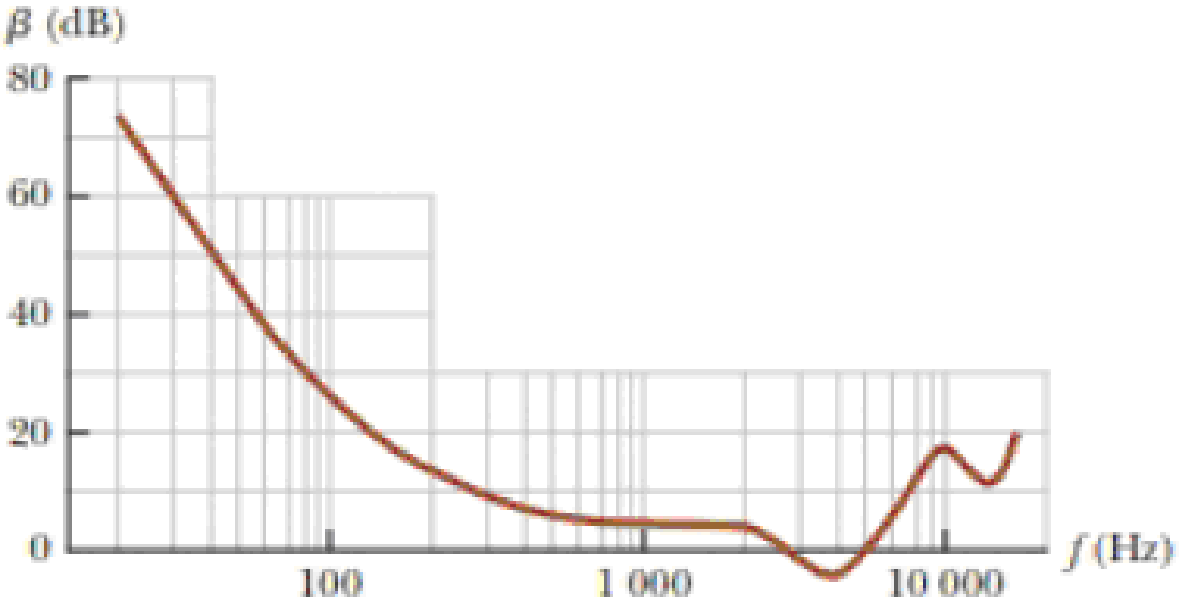
Concept explainers
Ever since seeing Figure 16.22 in the previous chapter, you have been fascinated with the hearing response in humans. You have set up an apparatus that allows you to determine your own threshold of hearing as a function of frequency. After performing the experiment and recording the results, you graph the results, which look like Figure P17.22. You are intrigued by the two dips in the curve at the right-hand side of the graph. You measure carefully and find that the minimum values of these dips occur at 3 800 Hz and 11 500 Hz. Performing some online research, you discover that the outer canal of the human ear can be modeled as an air column open at the outer end and closed at the inner end by the eardrum. You use this information to determine the length of the outer canal in your car.
Figure P17.22

Trending nowThis is a popular solution!

Chapter 17 Solutions
Physics for Scientists and Engineers with Modern Physics
- Item 9 Learning Goal: To learn the properties of logarithms and how to manipulate them when solving sound problems. The intensity of sound is the power of the sound waves divided by the area on which they are incident. Intensity is measured in watts per square meter, or W/m². The human ear can detect a remarkable range of sound intensities. The quietest sound that we can hear has an intensity of 10-12 W/m², and we begin to feel pain when the intensity reaches 1 W/m². Since the intensities matter people in everyday life cover a range of 12 orders of magnitude, intensities are usually converted to a logarithmic scale called the sound intensity level 3, which is measured in decibels (dB). For a given sound intensity I, B is found from the equation ß = (10 dB) log (1), where Io = 1.0 × 10-¹2 W/m². ▼ The logarithm of x, written log(x), tells you the power to which you would raise 10 to get æ. So, if y = log(x), then x = 10³. It is easy to take the logarithm of a number such as 10², because…arrow_forwardQ#3: Why the noise pollution is considered a serious occupational health hazard? How can we prevent and control noise pollution in the workplace? What are the measurement units of noise? How can we measure the sound pressure level of the noise generated by a machinearrow_forwardTwo students hear the same sound and their eardrums receive the same power from the sound wave. The sound intensity at the eardrums of the first student is 0.93 W/m2, while at the eardrums of the second student the sound intensity is 1.16 times greater. If the diameter of the second student’s eardrum is 1.1 cm, how much acoustic power, in microwatts, is striking each of his (and the other student’s) eardrums?arrow_forward
- You work at a building site and the noise level has been measured at 95 dB. You need to wear earplugs rated to reduce the sound intensity by 32 dB. If your eardrum has a diameter of 8.4 mm, what is the power received by one eardrum after you put in an earplug.arrow_forwardA sound wave with intensity 2 x 10 -3 W/m2 is perceived to be modestly loud. Your eardrum is 6 mm in diameter. How much energy will be transferred to your eardrum while listening to this sound for 1 minute?arrow_forwardChapter 16, Problem 069 Your answer is partially correct. Try again. ES. lem The bellow of a territorial bull hippopotamus is measured at 116 dB above the threshold of hearing. What is the sound intensity? Hint: The threshold of human hearing is Io = 1.00 x 10-12 W/m2. plem %3D blem Number Units W/m^2 ▼ oblem the tolerance is +/-5% oblem roblem SHOW HINT Problem LINK TO TEXT Problem Problem By accessing this Question Assistance, you will learn while you earn points based on the Point Potential Policy set by your instructor. Problem Question Attempts: 1 of 6 used SUBMIT ANSWER SAVE FOR LATER Problem Earn Maximum Points available only if you 8:02 PM 4/29/2020 19 e here to search 21 ASL pause break prt sc sysrq f11 f12 insert f8 f9 f10 f4 f5 f6 f7 f2 f3 backspace & %24 80 4 96arrow_forward
- The decibel scale is useful because A it can be used to represent the very large range of pressure differences that humans hear. B it is a measure of loudness and not stimulus amplitude. C loudness is related only to the frequency of the stimulus. D loudness is related only to the amplitude of the stimulus.arrow_forwardSperm whales, just like bats, use echolocation to find prey. A sperm whale’s vocal system creates a single sharp click, but the emitted sound consists of several equally spaced clicks of decreasing intensity. Researchers use the time interval between the clicks to estimate the size of the whale that created them. Explain how this might be done.arrow_forwardWhat is the threshold of pain (l = 1 W/m2) in dB? the intoncarrow_forward
- For Exercise, the formula L = 10 log (£) gives the loudness of sound L (in dB) based on the intensity of sound I (in W/m2). The value 10 = 10-12 W/m2 is the minimal threshold for hearing for midfrequency sounds. Hearing impairment is often measured according to the minimal sound level (in dB) detected by an individual for sounds at various frequencies. For one frequency, the table depicts the level of hearing impairment. |Category Loudness (dB) Mild 26 sL 90 Determine the range that represents the intensity of sound that can be heard by an individual with severe hearing impairment.arrow_forwardFor Exercise, the formula L = 10 log (£) gives the loudness of sound L (in dB) based on the intensity of sound I (in W/m2). The value 10 = 10-12 W/m2 is the minimal threshold for hearing for midfrequency sounds. Hearing impairment is often measured according to the minimal sound level (in dB) detected by an individual for sounds at various frequencies. For one frequency, the table depicts the level of hearing impairment. Category Loudness (dB) Mild 26 sLs 40 Moderate 41 90 a. If the minimum intensity heard by an individual is 3.4 x 10-8 W/m2, determine if the individual has a hearing impairment. b. If the minimum loudness of sound detected by an individual is 30 dB, determine the corresponding intensity of sound.arrow_forwardSound is detected when a sound wave causes the eardrum to vibrate. Typically, the diameter of the eardrum is about 8.4 mm in humans. When someone speaks to you in a normal tone of voice, the sound intensity at your ear is approximately 1.0 × 10-6 W/m². What is the power delivered to your eardrum? Express your answer in watts. P = 17 ΑΣΦ ? Warrow_forward
 Physics for Scientists and Engineers with Modern ...PhysicsISBN:9781337553292Author:Raymond A. Serway, John W. JewettPublisher:Cengage Learning
Physics for Scientists and Engineers with Modern ...PhysicsISBN:9781337553292Author:Raymond A. Serway, John W. JewettPublisher:Cengage Learning Physics for Scientists and EngineersPhysicsISBN:9781337553278Author:Raymond A. Serway, John W. JewettPublisher:Cengage Learning
Physics for Scientists and EngineersPhysicsISBN:9781337553278Author:Raymond A. Serway, John W. JewettPublisher:Cengage Learning

